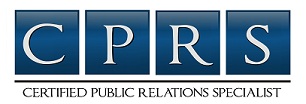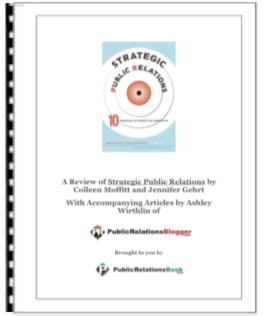________________________________________________________________________
 Powerful is a strong word. But it fits here. As a business, non-profit or association manager, you create powerful advantage for yourself when you do something positive about the behaviors of those important outside audiences of yours that MOST affect your department, division or subsidiary.
Powerful is a strong word. But it fits here. As a business, non-profit or association manager, you create powerful advantage for yourself when you do something positive about the behaviors of those important outside audiences of yours that MOST affect your department, division or subsidiary.
That’s because you are using the fundamental premise of public relations to deliver the kind of external stakeholder behavior change that leads directly to achieving your managerial objectives.
And perhaps most powerfully, you do so by persuading many of those important outside folks to your way of thinking, then by moving them to take actions that help your unit succeed.
Yes, that’s powerful! Especially when it leads to advantages like these: membership applications on the rise; customers making repeat purchases; fresh proposals for strategic alliances and joint ventures in the inbox; community leaders seeking you out; welcome bounces in show room visits; prospects starting to do business with you; capital givers or specifying sources looking your way, and even politicians and legislators beginning to view you as a key member of the business, non-profit or association communities.
You need two lucky breaks here: first, a PR blueprint you can rely on, say, like this one: people act on their own perception of the facts before them, which leads to predictable behaviors about which something can be done. When we create, change or reinforce that opinion by reaching, persuading and moving- to-desired-action the very people whose behaviors affect the organization the most, the public relations mission is accomplished.,
And second, PR team members who understand that blueprint and commit themselves to its implementation, starting with key audience perception monitoring. Let’s face it, your PR people ARE in the perception and behavior business to begin with, so they should be of real use for this initial opinion monitoring project.
But remember that just because someone describes him/herself as a public relations person doesn’t guarantee they’ve bought the whole loaf. Make certain the public relations people assigned to your unit really believe - deep down -- why it’s SO important to know how your most important outside audiences perceive your operations, products or services. Make sure they accept the reality that perceptions almost always lead to behaviors that can help or hurt your unit.
Discuss with them your plan for monitoring and gathering perceptions by questioning members of your most important outside audiences. Questions like these: how much do you know about our chief executive? Have you had prior contact with us and were you pleased with the interchange? How much do you know about our services or products and employees? Have you experienced problems with our people or procedures?
While, as noted, your PR people are in the perception and behavior business to begin with, professional survey firms are always available, but they can be very expensive. Nevertheless, whether it’s your people or a survey firm asking the questions, the objective remains the same: identify untruths, false assumptions, unfounded rumors, inaccuracies, misconceptions and any other negative perception that might translate into hurtful behaviors.
Your PR goal, of course, will be to do something about the most serious distortions you discovered during your key audience perception monitoring. Will it be to straighten out that dangerous misconception? Correct that gross inaccuracy? Or, stop that potentially fatal rumor dead in its tracks?
As it turns out, you won’t get there at all without the right strategy to tell you how to proceed. But remember that there are just three strategic options available when it comes to doing something about perception and opinion. Change existing perception, create perception where there may be none, or reinforce it. The wrong strategy pick will taste like lemon sauce on your chocolate ice cream. So please be certain the new strategy fits comfortably with your new public relations goal. You wouldn’t want to select “change” when the facts dictate a “reinforce” strategy.
At this juncture, you must put together a superbly moving message and aim it at members of your target audience. Always a challenge to put together action-forcing language that will help persuade any audience to your way of thinking.
You need your first-string varsity writer for this one because s/he must create some very special, corrective language. Words that are not only compelling, persuasive and believable, but clear and factual if they are to shift perception/opinion towards your point of view and lead to the behaviors you have in mind.
After bouncing it off your PR colleagues for impact and persuasiveness, it’s on to the next selection process -- the communications tactics most likely to carry your message to the attention of your target audience. You can pick from dozens that are available. From speeches, facility tours, emails and brochures to consumer briefings, media interviews, newsletters, personal meetings and many others. Just be certain that the tactics you pick are known to reach folks like your audience members,
Since the credibility of the message is always at stake, you may wish to unveil it before smaller meetings and presentations rather than using higher-profile news releases.
Calls for progress reports will soon appear, which signals to you and your PR team to get busy on a second perception monitoring session with members of your external audience. You’ll want to use many of the same questions used in the first benchmark session. Difference this time is that you will be watching very carefully for signs that the bad news perception is being altered in your direction.
I’ve always considered ourselves fortunate that such matters usually can be accelerated simply by adding more communi- cations tactics as well as increasing their frequencies.
What you want the new PR plan to accomplish is to persuade your most important outside stakeholders to your way of thinking, then move them to behave in a way that leads to the success of your department, division or subsidiary.
Yes, powerful is a strong word but certainly not too strong when the people you deal with do, in fact, behave suspiciously like everyone else - they act upon their perceptions of the facts they hear about you and your operation. Leaving you little choice but to deal promptly and effectively with those perceptions by doing what is necessary to reach and move your key external audiences to actions you desire.
Please feel free to publish this article and resource box in your ezine, newsletter, offline publication or website.
Robert A. Kelly © 2004.
About The Author
Bob Kelly counsels, writes and speaks to business, non-profit and association managers about using the fundamental premise of public relations to achieve their operating objectives. He has been DPR, Pepsi-Cola Co.; AGM-PR, Texaco Inc.; VP-PR, Olin Corp.; VP-PR, Newport News Shipbuilding & Drydock Co.; director of communi- cations, U.S. Department of the Interior, and deputy assistant press secretary, The White House. He holds a bachelor of science degree from Columbia University, major in public rlations.
Visit his website here.
Article Source.
Tags: public relations planning, PR, public relations
Planning and Focus Can Create a Great Advantage in Public Relations
________________________________________
 Powerful is a strong word. But it fits here. As a business, non-profit or association manager, you create powerful advantage for yourself when you do something positive about the behaviors of those important outside audiences of yours that MOST affect your department, division or subsidiary.
Powerful is a strong word. But it fits here. As a business, non-profit or association manager, you create powerful advantage for yourself when you do something positive about the behaviors of those important outside audiences of yours that MOST affect your department, division or subsidiary.That’s because you are using the fundamental premise of public relations to deliver the kind of external stakeholder behavior change that leads directly to achieving your managerial objectives.
And perhaps most powerfully, you do so by persuading many of those important outside folks to your way of thinking, then by moving them to take actions that help your unit succeed.
Yes, that’s powerful! Especially when it leads to advantages like these: membership applications on the rise; customers making repeat purchases; fresh proposals for strategic alliances and joint ventures in the inbox; community leaders seeking you out; welcome bounces in show room visits; prospects starting to do business with you; capital givers or specifying sources looking your way, and even politicians and legislators beginning to view you as a key member of the business, non-profit or association communities.
You need two lucky breaks here: first, a PR blueprint you can rely on, say, like this one: people act on their own perception of the facts before them, which leads to predictable behaviors about which something can be done. When we create, change or reinforce that opinion by reaching, persuading and moving- to-desired-action the very people whose behaviors affect the organization the most, the public relations mission is accomplished.,
And second, PR team members who understand that blueprint and commit themselves to its implementation, starting with key audience perception monitoring. Let’s face it, your PR people ARE in the perception and behavior business to begin with, so they should be of real use for this initial opinion monitoring project.
But remember that just because someone describes him/herself as a public relations person doesn’t guarantee they’ve bought the whole loaf. Make certain the public relations people assigned to your unit really believe - deep down -- why it’s SO important to know how your most important outside audiences perceive your operations, products or services. Make sure they accept the reality that perceptions almost always lead to behaviors that can help or hurt your unit.
Discuss with them your plan for monitoring and gathering perceptions by questioning members of your most important outside audiences. Questions like these: how much do you know about our chief executive? Have you had prior contact with us and were you pleased with the interchange? How much do you know about our services or products and employees? Have you experienced problems with our people or procedures?
While, as noted, your PR people are in the perception and behavior business to begin with, professional survey firms are always available, but they can be very expensive. Nevertheless, whether it’s your people or a survey firm asking the questions, the objective remains the same: identify untruths, false assumptions, unfounded rumors, inaccuracies, misconceptions and any other negative perception that might translate into hurtful behaviors.
Your PR goal, of course, will be to do something about the most serious distortions you discovered during your key audience perception monitoring. Will it be to straighten out that dangerous misconception? Correct that gross inaccuracy? Or, stop that potentially fatal rumor dead in its tracks?
As it turns out, you won’t get there at all without the right strategy to tell you how to proceed. But remember that there are just three strategic options available when it comes to doing something about perception and opinion. Change existing perception, create perception where there may be none, or reinforce it. The wrong strategy pick will taste like lemon sauce on your chocolate ice cream. So please be certain the new strategy fits comfortably with your new public relations goal. You wouldn’t want to select “change” when the facts dictate a “reinforce” strategy.
At this juncture, you must put together a superbly moving message and aim it at members of your target audience. Always a challenge to put together action-forcing language that will help persuade any audience to your way of thinking.
You need your first-string varsity writer for this one because s/he must create some very special, corrective language. Words that are not only compelling, persuasive and believable, but clear and factual if they are to shift perception/opinion towards your point of view and lead to the behaviors you have in mind.
After bouncing it off your PR colleagues for impact and persuasiveness, it’s on to the next selection process -- the communications tactics most likely to carry your message to the attention of your target audience. You can pick from dozens that are available. From speeches, facility tours, emails and brochures to consumer briefings, media interviews, newsletters, personal meetings and many others. Just be certain that the tactics you pick are known to reach folks like your audience members,
Since the credibility of the message is always at stake, you may wish to unveil it before smaller meetings and presentations rather than using higher-profile news releases.
Calls for progress reports will soon appear, which signals to you and your PR team to get busy on a second perception monitoring session with members of your external audience. You’ll want to use many of the same questions used in the first benchmark session. Difference this time is that you will be watching very carefully for signs that the bad news perception is being altered in your direction.
I’ve always considered ourselves fortunate that such matters usually can be accelerated simply by adding more communi- cations tactics as well as increasing their frequencies.
What you want the new PR plan to accomplish is to persuade your most important outside stakeholders to your way of thinking, then move them to behave in a way that leads to the success of your department, division or subsidiary.
Yes, powerful is a strong word but certainly not too strong when the people you deal with do, in fact, behave suspiciously like everyone else - they act upon their perceptions of the facts they hear about you and your operation. Leaving you little choice but to deal promptly and effectively with those perceptions by doing what is necessary to reach and move your key external audiences to actions you desire.
Please feel free to publish this article and resource box in your ezine, newsletter, offline publication or website.
Robert A. Kelly © 2004.
About The Author
Bob Kelly counsels, writes and speaks to business, non-profit and association managers about using the fundamental premise of public relations to achieve their operating objectives. He has been DPR, Pepsi-Cola Co.; AGM-PR, Texaco Inc.; VP-PR, Olin Corp.; VP-PR, Newport News Shipbuilding & Drydock Co.; director of communi- cations, U.S. Department of the Interior, and deputy assistant press secretary, The White House. He holds a bachelor of science degree from Columbia University, major in public rlations.
Visit his website here.
Article Source.
Tags: public relations planning, PR, public relations
Subscribe to:
Post Comments (Atom)






Comments (0)
Post a Comment